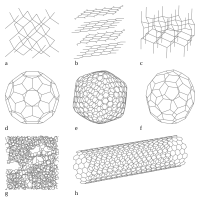
Photo from wikipedia
Identification and evaluation of defect levels in low-dimensional materials is an important aspect in quantum science. In this article, we report a facile synthesis method of low-dimensional hexagonal boron nitride… Click to show full abstract
Identification and evaluation of defect levels in low-dimensional materials is an important aspect in quantum science. In this article, we report a facile synthesis method of low-dimensional hexagonal boron nitride (h-BN) and study light emission characteristics due to the defects. The thermal annealing procedure is optimized to obtain clean multilayered h-BN as revealed by transmission electron microscopy. UV–vis spectroscopy shows the optical energy gap of 5.28 eV, which is comparable to the reported energy gap for exfoliated, clean h-BN samples. X-ray photoelectron spectroscopy reveals the location of the valence band edge at 2 eV. The optimized synthesis route of h-BN generates two kinds of defects, which are characterized using room-temperature photoluminescence (PL) measurements. The defects emit light at 4.18 eV [deep-UV (DUV)] and 3.44 eV (UV) photons. The intensity of PL has an oscillatory dependence on the excitation energy for the defect emitting DUV light. A series of spectral lines are observed with the energy ranging between 2.56 and 3.44 eV. The average peak-to-peak energy separation is about 125 meV. The locations of the spectral lines can be modeled using Franck–Condon-type transition and associated with displaced harmonic oscillator approximation. Our facile route gives an easier approach to prepare clean h-BN, which is essential for classical two-dimensional material-based electronics and single-photon-based quantum devices.
Journal Title: ACS Omega
Year Published: 2022
Link to full text (if available)
Share on Social Media: Sign Up to like & get
recommendations!